Developing and Using Emotional Intelligence in the Workplace Report
VerifiedAdded on 2020/12/29
|24
|5674
|307
Report
AI Summary
This report delves into the multifaceted realm of emotional intelligence (EI), examining its core components and practical applications within a professional context. It begins by defining EI and its four key elements: self-awareness, self-management, social awareness, and relationship management. The report then explores self-assessment, identifying personal emotional strengths and weaknesses, and analyzing workplace stressors and emotional triggers. It further investigates the importance of emotional control for managers and leaders, offering insights into managing workplace incidents and conflicts. Activity 2 discusses potential emotional states in co-workers, identifying emotional cues and exploring universal emotions. The report also covers leadership styles, conflict resolution, and the impact of emotions on decision-making. Practical exercises, including identifying leadership styles and applying EI principles, are incorporated to enhance understanding. Ultimately, the report underscores the significance of EI in fostering a positive and productive work environment, promoting effective communication, and building strong interpersonal relationships.
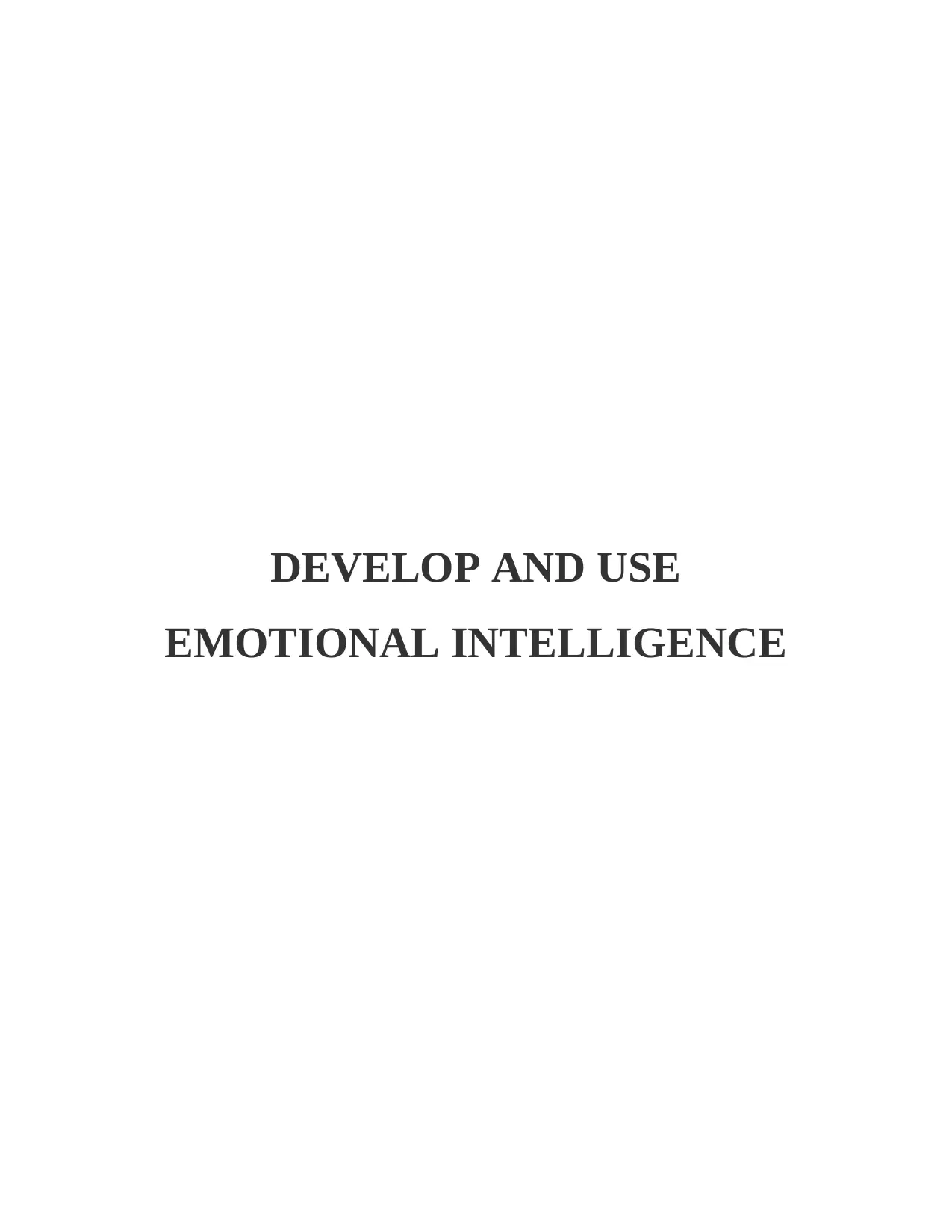
DEVELOP AND USE
EMOTIONAL INTELLIGENCE
EMOTIONAL INTELLIGENCE
Paraphrase This Document
Need a fresh take? Get an instant paraphrase of this document with our AI Paraphraser

TABLE OF CONTENTS
INTRODUCTION...........................................................................................................................4
Activity 1 A .....................................................................................................................................4
Assessing the four components of the emotional intelligence. ..................................................4
Emotional strengths and weakness are listed below ..................................................................5
Activity 1B ......................................................................................................................................6
Identify your own personal stressor within the workplace.........................................................6
Identify the emotional state it causes within you and whether it is a positive or negative state.6
Identify your own emotional triggers in relation to your personal work related stressors, the
emotional strength you would draw on to deal with it................................................................6
Why is it important for managers and leaders to keep control of their emotions in the
workplace?..................................................................................................................................7
Workplace incident in which one can not control emotions.......................................................7
ACTIVITY 2....................................................................................................................................8
Activity 2A .................................................................................................................................8
Identify the possible emotional states that you might encounter in your co- workers................8
Identify the emotional cue for each of the emotional state. .......................................................8
What are the six basic emotions that studies have proven are universal in all cultures?............8
.....................................................................................................................................................9
Activity 2C .................................................................................................................................9
When dealing with people in your organisation, what matters might arise?..............................9
To deal with the people in the organization following are the conflicts may arise-......................9
Six styles of leaderships .............................................................................................................9
Situation where leadership style can be applied.......................................................................10
Activity 2D ...............................................................................................................................11
Decision making process while taking in to account emotions of others and its impact on
individuals and organisation.....................................................................................................11
ACTIVITY 3..................................................................................................................................11
Activity 3A................................................................................................................................11
Activity 3B................................................................................................................................11
INTRODUCTION...........................................................................................................................4
Activity 1 A .....................................................................................................................................4
Assessing the four components of the emotional intelligence. ..................................................4
Emotional strengths and weakness are listed below ..................................................................5
Activity 1B ......................................................................................................................................6
Identify your own personal stressor within the workplace.........................................................6
Identify the emotional state it causes within you and whether it is a positive or negative state.6
Identify your own emotional triggers in relation to your personal work related stressors, the
emotional strength you would draw on to deal with it................................................................6
Why is it important for managers and leaders to keep control of their emotions in the
workplace?..................................................................................................................................7
Workplace incident in which one can not control emotions.......................................................7
ACTIVITY 2....................................................................................................................................8
Activity 2A .................................................................................................................................8
Identify the possible emotional states that you might encounter in your co- workers................8
Identify the emotional cue for each of the emotional state. .......................................................8
What are the six basic emotions that studies have proven are universal in all cultures?............8
.....................................................................................................................................................9
Activity 2C .................................................................................................................................9
When dealing with people in your organisation, what matters might arise?..............................9
To deal with the people in the organization following are the conflicts may arise-......................9
Six styles of leaderships .............................................................................................................9
Situation where leadership style can be applied.......................................................................10
Activity 2D ...............................................................................................................................11
Decision making process while taking in to account emotions of others and its impact on
individuals and organisation.....................................................................................................11
ACTIVITY 3..................................................................................................................................11
Activity 3A................................................................................................................................11
Activity 3B................................................................................................................................11
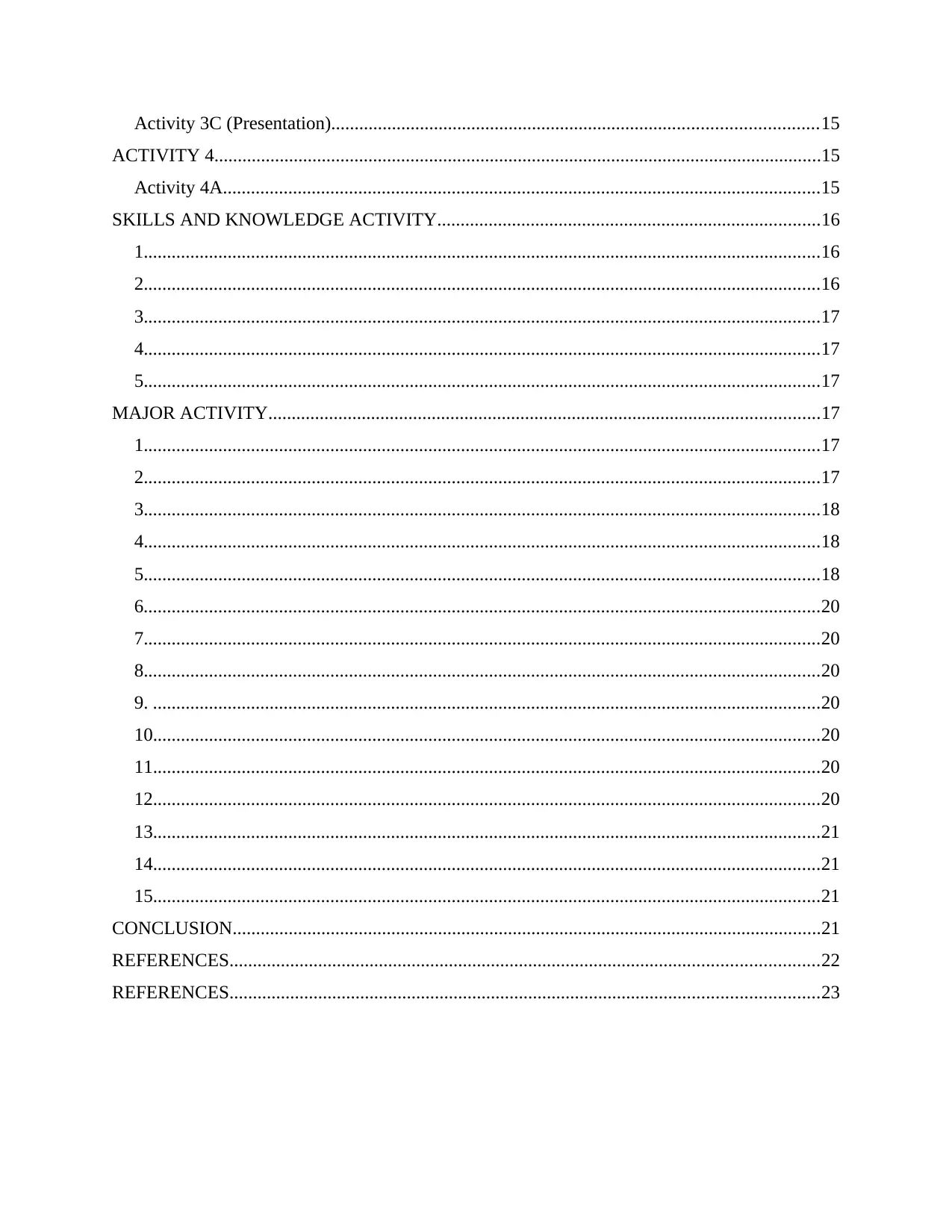
Activity 3C (Presentation)........................................................................................................15
ACTIVITY 4..................................................................................................................................15
Activity 4A................................................................................................................................15
SKILLS AND KNOWLEDGE ACTIVITY..................................................................................16
1.................................................................................................................................................16
2.................................................................................................................................................16
3.................................................................................................................................................17
4.................................................................................................................................................17
5.................................................................................................................................................17
MAJOR ACTIVITY......................................................................................................................17
1.................................................................................................................................................17
2.................................................................................................................................................17
3.................................................................................................................................................18
4.................................................................................................................................................18
5.................................................................................................................................................18
6.................................................................................................................................................20
7.................................................................................................................................................20
8.................................................................................................................................................20
9. ...............................................................................................................................................20
10...............................................................................................................................................20
11...............................................................................................................................................20
12...............................................................................................................................................20
13...............................................................................................................................................21
14...............................................................................................................................................21
15...............................................................................................................................................21
CONCLUSION..............................................................................................................................21
REFERENCES..............................................................................................................................22
REFERENCES..............................................................................................................................23
ACTIVITY 4..................................................................................................................................15
Activity 4A................................................................................................................................15
SKILLS AND KNOWLEDGE ACTIVITY..................................................................................16
1.................................................................................................................................................16
2.................................................................................................................................................16
3.................................................................................................................................................17
4.................................................................................................................................................17
5.................................................................................................................................................17
MAJOR ACTIVITY......................................................................................................................17
1.................................................................................................................................................17
2.................................................................................................................................................17
3.................................................................................................................................................18
4.................................................................................................................................................18
5.................................................................................................................................................18
6.................................................................................................................................................20
7.................................................................................................................................................20
8.................................................................................................................................................20
9. ...............................................................................................................................................20
10...............................................................................................................................................20
11...............................................................................................................................................20
12...............................................................................................................................................20
13...............................................................................................................................................21
14...............................................................................................................................................21
15...............................................................................................................................................21
CONCLUSION..............................................................................................................................21
REFERENCES..............................................................................................................................22
REFERENCES..............................................................................................................................23
⊘ This is a preview!⊘
Do you want full access?
Subscribe today to unlock all pages.

Trusted by 1+ million students worldwide

INTRODUCTION
Activity 1 A
Assessing the four components of the emotional intelligence.
Emotional intelligence is about to recognizing and managing your emotions and those of others.
Emotional intelligence is the capacity to recognize, use understand, and manages emotions to
improve the communications.
Individual's everyday life is affected by the emotional intelligence. The individual's
performance is being determine by the output of the physical capacity, mental health, even the
relationship of the management. The components of the emotional intelligence are classified into
four major categories. These are self awareness, self management, social awareness and
relationship management. These all are described under-
self awareness
Self awareness is about to knowing yourself. It indicates that how you know yourself and
how you accurately assess your emotions. Know a days people are so busy, they do not have
time for them to think about what they responding to situations and how we come across. To
recognize the self awareness, the other important source is to know how the others responds to
us. Sometime this task became challenging because we tend to see what we want to see. If you
want to grow your self awareness it is very important to consider the building time for reflection
into your days. Therefore, self awareness is to about knowing yourself. To understand your
strength and weaknesses that how they affect your thoughts and behavior.
Self management
To manage yourself is the foremost important thing in individuals life. Self management
includes the ways to control the emotions (Joseph and et.al., 2015). The emotions to be control
are impulsive feelings, behaviors, quick response, etc. it presents the ways to manage the stress
(e.g. exercise, eating healthy) and the proper utilization of these tools. This helps in the
improvement of transparency, achievement, and optimism. Reacting and responding towards the
situation have great difference.
To answer the following question will identify the power of the self management.
When you get an irritating email, do you write back right away?
Activity 1 A
Assessing the four components of the emotional intelligence.
Emotional intelligence is about to recognizing and managing your emotions and those of others.
Emotional intelligence is the capacity to recognize, use understand, and manages emotions to
improve the communications.
Individual's everyday life is affected by the emotional intelligence. The individual's
performance is being determine by the output of the physical capacity, mental health, even the
relationship of the management. The components of the emotional intelligence are classified into
four major categories. These are self awareness, self management, social awareness and
relationship management. These all are described under-
self awareness
Self awareness is about to knowing yourself. It indicates that how you know yourself and
how you accurately assess your emotions. Know a days people are so busy, they do not have
time for them to think about what they responding to situations and how we come across. To
recognize the self awareness, the other important source is to know how the others responds to
us. Sometime this task became challenging because we tend to see what we want to see. If you
want to grow your self awareness it is very important to consider the building time for reflection
into your days. Therefore, self awareness is to about knowing yourself. To understand your
strength and weaknesses that how they affect your thoughts and behavior.
Self management
To manage yourself is the foremost important thing in individuals life. Self management
includes the ways to control the emotions (Joseph and et.al., 2015). The emotions to be control
are impulsive feelings, behaviors, quick response, etc. it presents the ways to manage the stress
(e.g. exercise, eating healthy) and the proper utilization of these tools. This helps in the
improvement of transparency, achievement, and optimism. Reacting and responding towards the
situation have great difference.
To answer the following question will identify the power of the self management.
When you get an irritating email, do you write back right away?
Paraphrase This Document
Need a fresh take? Get an instant paraphrase of this document with our AI Paraphraser
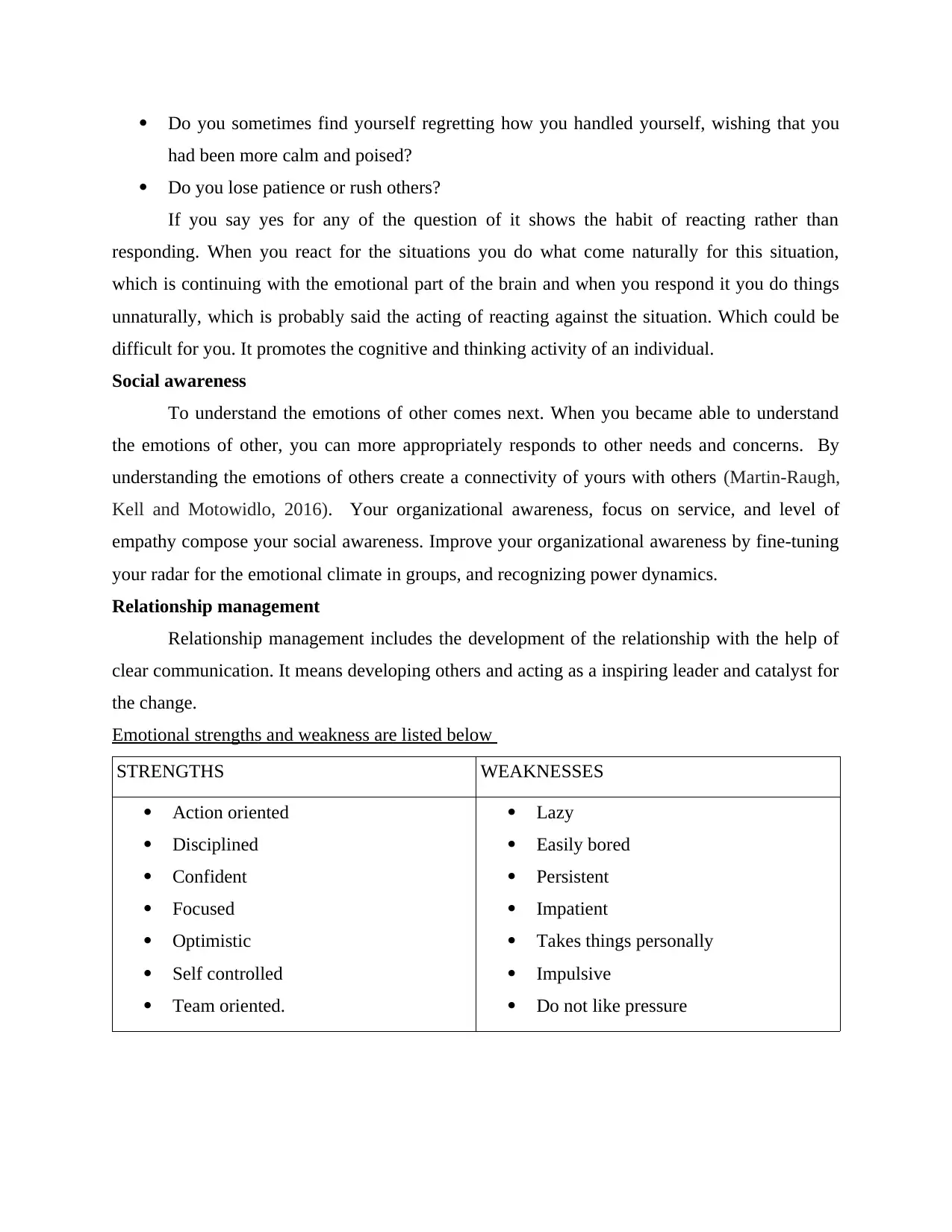
Do you sometimes find yourself regretting how you handled yourself, wishing that you
had been more calm and poised?
Do you lose patience or rush others?
If you say yes for any of the question of it shows the habit of reacting rather than
responding. When you react for the situations you do what come naturally for this situation,
which is continuing with the emotional part of the brain and when you respond it you do things
unnaturally, which is probably said the acting of reacting against the situation. Which could be
difficult for you. It promotes the cognitive and thinking activity of an individual.
Social awareness
To understand the emotions of other comes next. When you became able to understand
the emotions of other, you can more appropriately responds to other needs and concerns. By
understanding the emotions of others create a connectivity of yours with others (Martin-Raugh,
Kell and Motowidlo, 2016). Your organizational awareness, focus on service, and level of
empathy compose your social awareness. Improve your organizational awareness by fine-tuning
your radar for the emotional climate in groups, and recognizing power dynamics.
Relationship management
Relationship management includes the development of the relationship with the help of
clear communication. It means developing others and acting as a inspiring leader and catalyst for
the change.
Emotional strengths and weakness are listed below
STRENGTHS WEAKNESSES
Action oriented
Disciplined
Confident
Focused
Optimistic
Self controlled
Team oriented.
Lazy
Easily bored
Persistent
Impatient
Takes things personally
Impulsive
Do not like pressure
had been more calm and poised?
Do you lose patience or rush others?
If you say yes for any of the question of it shows the habit of reacting rather than
responding. When you react for the situations you do what come naturally for this situation,
which is continuing with the emotional part of the brain and when you respond it you do things
unnaturally, which is probably said the acting of reacting against the situation. Which could be
difficult for you. It promotes the cognitive and thinking activity of an individual.
Social awareness
To understand the emotions of other comes next. When you became able to understand
the emotions of other, you can more appropriately responds to other needs and concerns. By
understanding the emotions of others create a connectivity of yours with others (Martin-Raugh,
Kell and Motowidlo, 2016). Your organizational awareness, focus on service, and level of
empathy compose your social awareness. Improve your organizational awareness by fine-tuning
your radar for the emotional climate in groups, and recognizing power dynamics.
Relationship management
Relationship management includes the development of the relationship with the help of
clear communication. It means developing others and acting as a inspiring leader and catalyst for
the change.
Emotional strengths and weakness are listed below
STRENGTHS WEAKNESSES
Action oriented
Disciplined
Confident
Focused
Optimistic
Self controlled
Team oriented.
Lazy
Easily bored
Persistent
Impatient
Takes things personally
Impulsive
Do not like pressure

Activity 1B
Identify your own personal stressor within the workplace.
My personal own stressor is work and internal sources of distress. With in workplace
work and internal source is the stressor for me. It includes work and employment concerns.
Being a manager in an organization lots of distress is there. Some causes of distress are listed
inside the table.
Causes of distress
Unproductive and time consuming meeting.
Lack of training necessary to do the job.
Conflicts with team mates and supervisors.
Making of presentation in front of colleagues and clients.
Job in security.
Inadequate power to carry out task.
Although stressor are not limited they keep on changing when the external situations
creates the problem. Some internal events like feelings, thought, and habitual behavior may
provide the negative effect. Some internal cause includes fears, worrying about the future events,
unrealistic, perfectionist expectations.
Activity 1C
Identify the emotional state it causes within you and whether it is a positive or negative state.
Among all my stresses I m taking conflicts with team mates and supervisor. Once due to
some reason an argument between me and my team mates occurs which resulted very bad impact
over my working. To work in an organization it is very important to listen each other and support
while achieving target (van der Linden and et.al., 2015). Due to lack of communication this
conflicts occur. So being a manager of that team I was in fear that this conflict can ruin the
working of my team. Late, it has effected negatively as our target was not completed till the
deadline.
Identify your own emotional triggers in relation to your personal work related stressors, the
emotional strength you would draw on to deal with it
Situation of fear
Identify your own personal stressor within the workplace.
My personal own stressor is work and internal sources of distress. With in workplace
work and internal source is the stressor for me. It includes work and employment concerns.
Being a manager in an organization lots of distress is there. Some causes of distress are listed
inside the table.
Causes of distress
Unproductive and time consuming meeting.
Lack of training necessary to do the job.
Conflicts with team mates and supervisors.
Making of presentation in front of colleagues and clients.
Job in security.
Inadequate power to carry out task.
Although stressor are not limited they keep on changing when the external situations
creates the problem. Some internal events like feelings, thought, and habitual behavior may
provide the negative effect. Some internal cause includes fears, worrying about the future events,
unrealistic, perfectionist expectations.
Activity 1C
Identify the emotional state it causes within you and whether it is a positive or negative state.
Among all my stresses I m taking conflicts with team mates and supervisor. Once due to
some reason an argument between me and my team mates occurs which resulted very bad impact
over my working. To work in an organization it is very important to listen each other and support
while achieving target (van der Linden and et.al., 2015). Due to lack of communication this
conflicts occur. So being a manager of that team I was in fear that this conflict can ruin the
working of my team. Late, it has effected negatively as our target was not completed till the
deadline.
Identify your own emotional triggers in relation to your personal work related stressors, the
emotional strength you would draw on to deal with it
Situation of fear
⊘ This is a preview!⊘
Do you want full access?
Subscribe today to unlock all pages.

Trusted by 1+ million students worldwide

Situations Response more likely to
trigger fear
Response less likely to
trigger fear
When the employees makes the
costly mistake at work
Question his or her ability to
do the job properly or blame
the worker.
Help the workers in problem
solving or remind the worker
that mistakes happen.
Activity 1D
Why is it important for managers and leaders to keep control of their emotions in the
workplace?
It is very important for the leaders and managers to keep control over the emotions as
leaders and managers who are emotionally intelligent fosters save environment, and makes feel
the employee safe and comfortable (Farnia, Nafukho and Petrides 2018). Having manager and
leader strong with the emotions leads good for the organization. Emotionally intelligent leaders
do not take the things personally and are able to work ahead with plans without worry about the
impact on their ego.
Activity 1E
Workplace incident in which one can not control emotions
Incident A sharing protect with 3 colleagues, one of
which was a person with whom I recently had
heated argument
Emotions I can not control
Angers: Me and other person had an argument related
with personal ethical norms and we both have
different opinion about the same. While doing
project our ethical values got clashed and we
ended up shouting on each other.
Sentiments In this whole scenario I cried a lot in front of
my 2 colleagues who are the best support to
me at office.
trigger fear
Response less likely to
trigger fear
When the employees makes the
costly mistake at work
Question his or her ability to
do the job properly or blame
the worker.
Help the workers in problem
solving or remind the worker
that mistakes happen.
Activity 1D
Why is it important for managers and leaders to keep control of their emotions in the
workplace?
It is very important for the leaders and managers to keep control over the emotions as
leaders and managers who are emotionally intelligent fosters save environment, and makes feel
the employee safe and comfortable (Farnia, Nafukho and Petrides 2018). Having manager and
leader strong with the emotions leads good for the organization. Emotionally intelligent leaders
do not take the things personally and are able to work ahead with plans without worry about the
impact on their ego.
Activity 1E
Workplace incident in which one can not control emotions
Incident A sharing protect with 3 colleagues, one of
which was a person with whom I recently had
heated argument
Emotions I can not control
Angers: Me and other person had an argument related
with personal ethical norms and we both have
different opinion about the same. While doing
project our ethical values got clashed and we
ended up shouting on each other.
Sentiments In this whole scenario I cried a lot in front of
my 2 colleagues who are the best support to
me at office.
Paraphrase This Document
Need a fresh take? Get an instant paraphrase of this document with our AI Paraphraser

Feedback
Manager He had an opinion that usually I am more
composed at office but this time he was
disappointed with my behavior. Also, he said
that two person can have different views on
same things that does not mean that we shall
argue about that same now and then.
Other colleagues All said that we both had a different opinion
about same and I should have kept my cool.
ACTIVITY 2
Activity 2A
Identify the possible emotional states that you might encounter in your co- workers.
Following are the possible emotional states are -
Anger- anger in work place can results from the frustration, interpersonal conflicts with
superiors of unfair treatments. Anger at workplace leads to the irrational behavior which can ruin
the workings.
Envy – it is very common to envy the accomplishments and rewards given to the fellow workers.
This can demotivate the co workers and their working too.
Identify the emotional cue for each of the emotional state.
Anger
One key for managing workplace anger is to remove yourself from the situation and
letting your anger subside. Then, when calmer, you can take more rational steps in dealing with
the situation that made you angry in the first place.
Envy
The key in dealing with envy is to analyze the situation and make sure that when you are
comparing yourself to others that you are using the right “comparison others.” For example, you
can’t compare yourself directly to someone with more experience, or service time.
Activity 2b
Manager He had an opinion that usually I am more
composed at office but this time he was
disappointed with my behavior. Also, he said
that two person can have different views on
same things that does not mean that we shall
argue about that same now and then.
Other colleagues All said that we both had a different opinion
about same and I should have kept my cool.
ACTIVITY 2
Activity 2A
Identify the possible emotional states that you might encounter in your co- workers.
Following are the possible emotional states are -
Anger- anger in work place can results from the frustration, interpersonal conflicts with
superiors of unfair treatments. Anger at workplace leads to the irrational behavior which can ruin
the workings.
Envy – it is very common to envy the accomplishments and rewards given to the fellow workers.
This can demotivate the co workers and their working too.
Identify the emotional cue for each of the emotional state.
Anger
One key for managing workplace anger is to remove yourself from the situation and
letting your anger subside. Then, when calmer, you can take more rational steps in dealing with
the situation that made you angry in the first place.
Envy
The key in dealing with envy is to analyze the situation and make sure that when you are
comparing yourself to others that you are using the right “comparison others.” For example, you
can’t compare yourself directly to someone with more experience, or service time.
Activity 2b
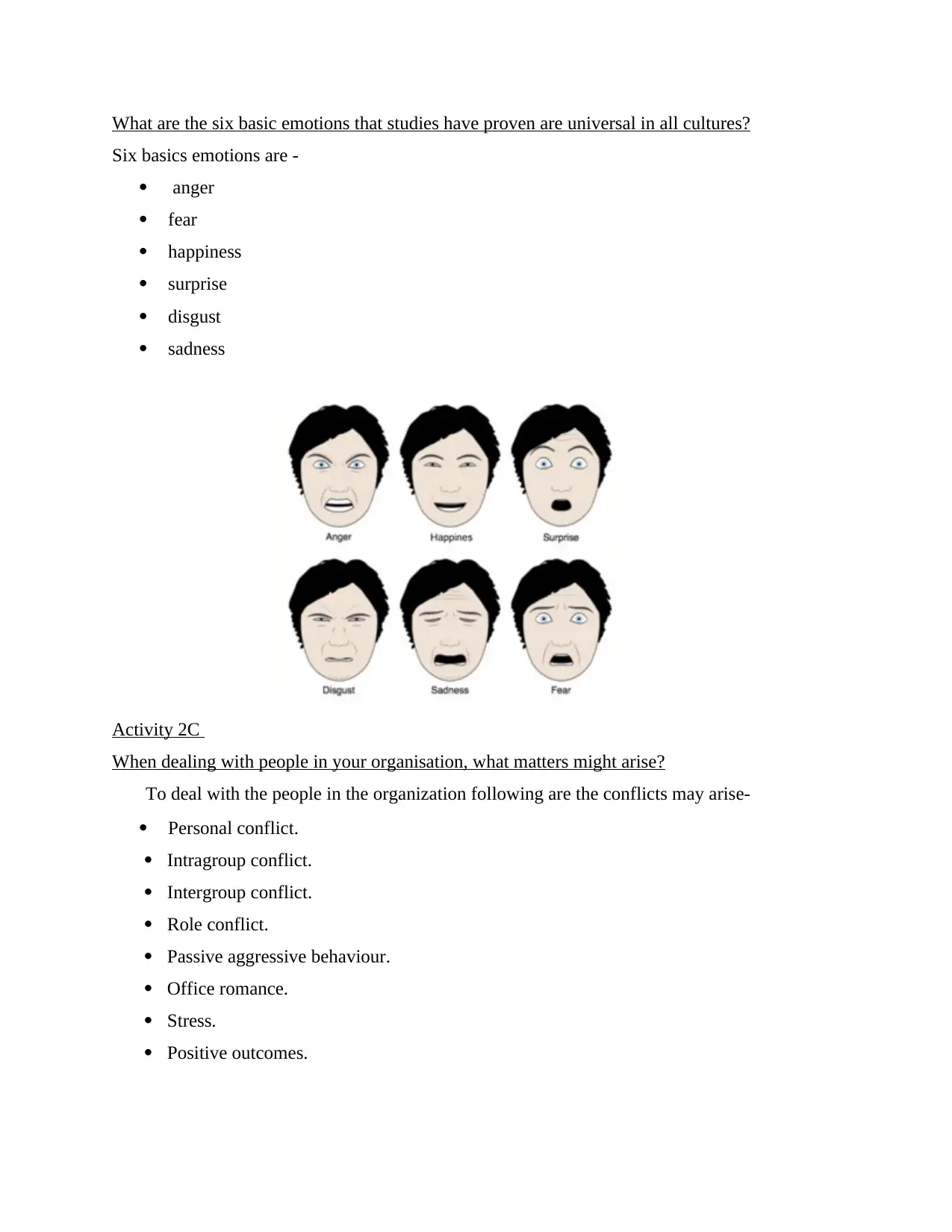
What are the six basic emotions that studies have proven are universal in all cultures?
Six basics emotions are -
anger
fear
happiness
surprise
disgust
sadness
Activity 2C
When dealing with people in your organisation, what matters might arise?
To deal with the people in the organization following are the conflicts may arise-
Personal conflict.
Intragroup conflict.
Intergroup conflict.
Role conflict.
Passive aggressive behaviour.
Office romance.
Stress.
Positive outcomes.
Six basics emotions are -
anger
fear
happiness
surprise
disgust
sadness
Activity 2C
When dealing with people in your organisation, what matters might arise?
To deal with the people in the organization following are the conflicts may arise-
Personal conflict.
Intragroup conflict.
Intergroup conflict.
Role conflict.
Passive aggressive behaviour.
Office romance.
Stress.
Positive outcomes.
⊘ This is a preview!⊘
Do you want full access?
Subscribe today to unlock all pages.

Trusted by 1+ million students worldwide
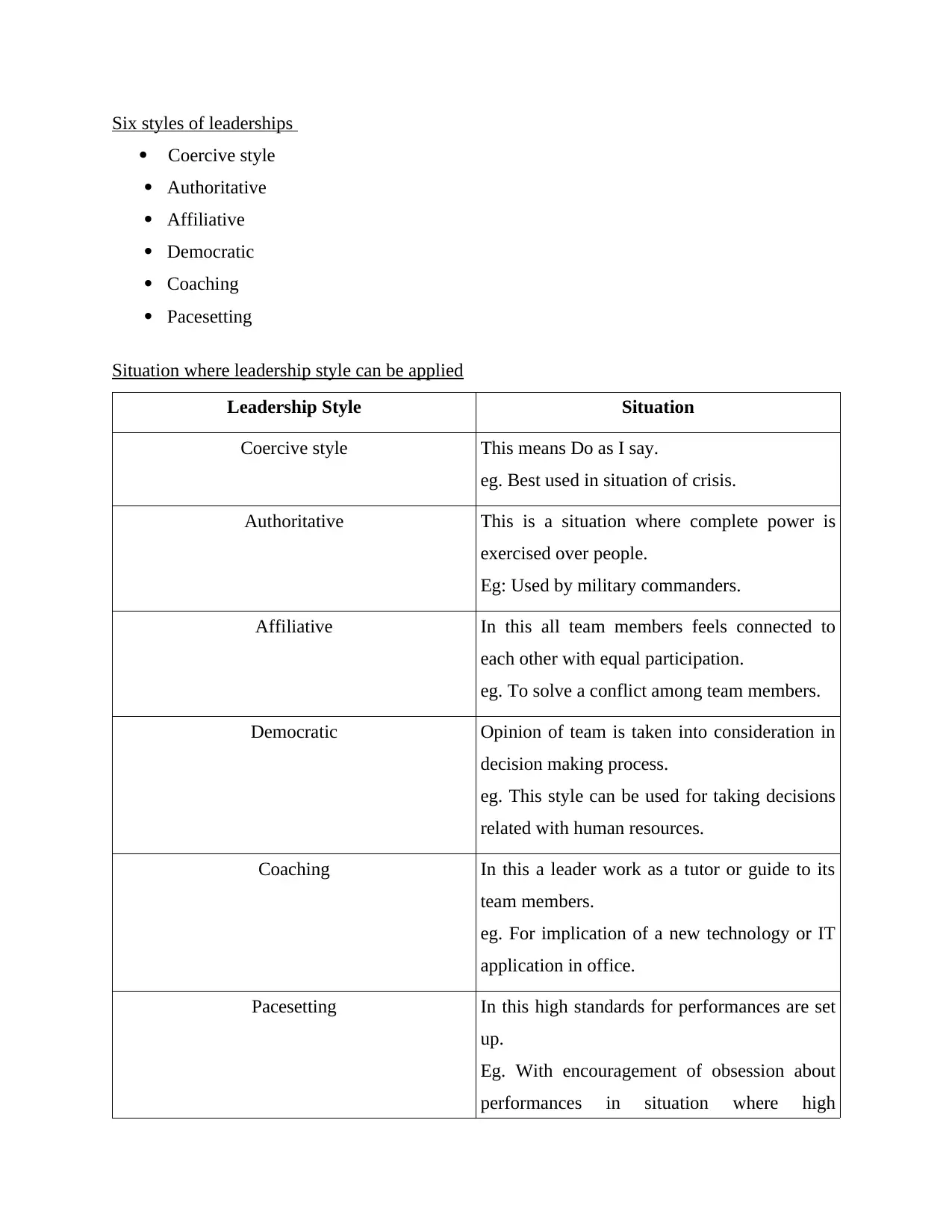
Six styles of leaderships
Coercive style
Authoritative
Affiliative
Democratic
Coaching
Pacesetting
Situation where leadership style can be applied
Leadership Style Situation
Coercive style This means Do as I say.
eg. Best used in situation of crisis.
Authoritative This is a situation where complete power is
exercised over people.
Eg: Used by military commanders.
Affiliative In this all team members feels connected to
each other with equal participation.
eg. To solve a conflict among team members.
Democratic Opinion of team is taken into consideration in
decision making process.
eg. This style can be used for taking decisions
related with human resources.
Coaching In this a leader work as a tutor or guide to its
team members.
eg. For implication of a new technology or IT
application in office.
Pacesetting In this high standards for performances are set
up.
Eg. With encouragement of obsession about
performances in situation where high
Coercive style
Authoritative
Affiliative
Democratic
Coaching
Pacesetting
Situation where leadership style can be applied
Leadership Style Situation
Coercive style This means Do as I say.
eg. Best used in situation of crisis.
Authoritative This is a situation where complete power is
exercised over people.
Eg: Used by military commanders.
Affiliative In this all team members feels connected to
each other with equal participation.
eg. To solve a conflict among team members.
Democratic Opinion of team is taken into consideration in
decision making process.
eg. This style can be used for taking decisions
related with human resources.
Coaching In this a leader work as a tutor or guide to its
team members.
eg. For implication of a new technology or IT
application in office.
Pacesetting In this high standards for performances are set
up.
Eg. With encouragement of obsession about
performances in situation where high
Paraphrase This Document
Need a fresh take? Get an instant paraphrase of this document with our AI Paraphraser
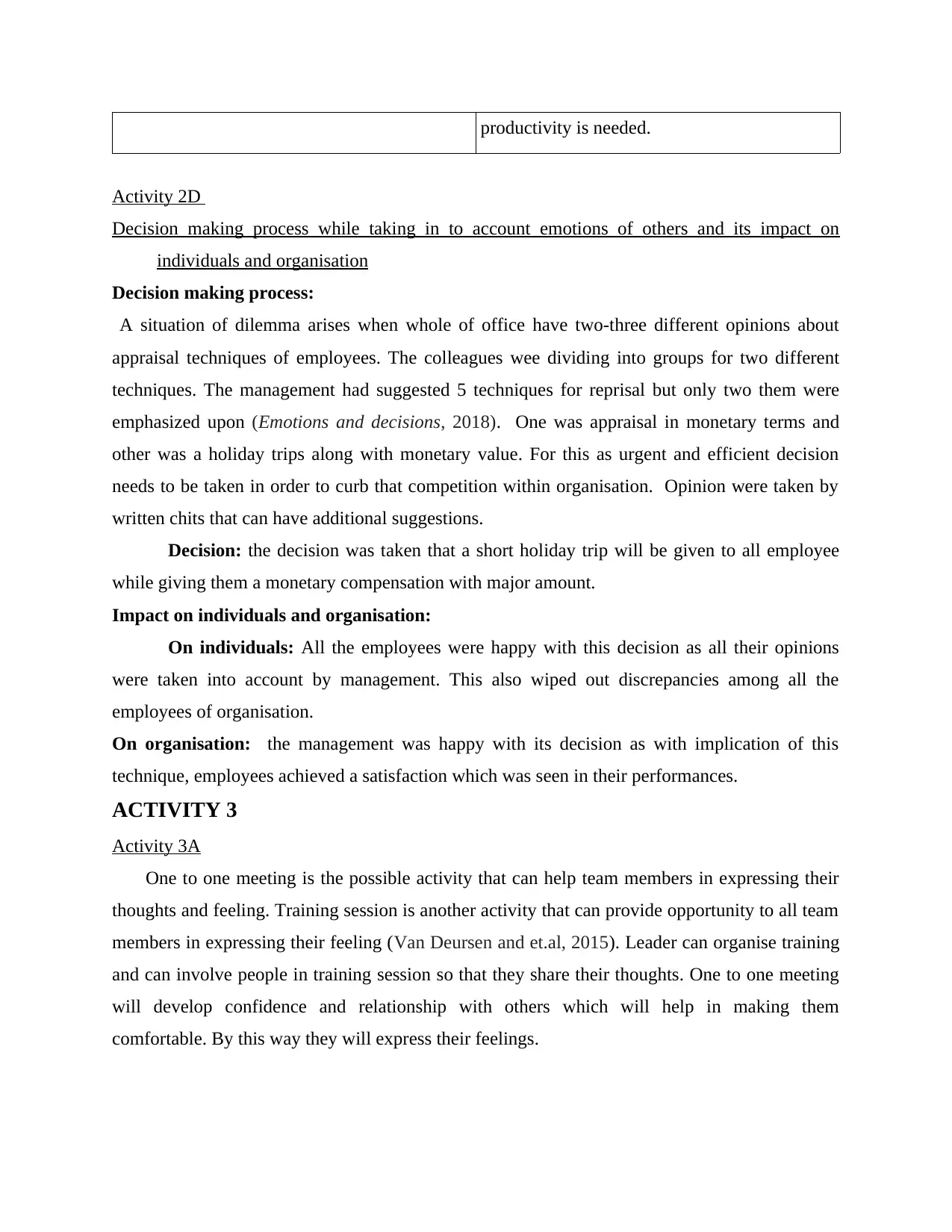
productivity is needed.
Activity 2D
Decision making process while taking in to account emotions of others and its impact on
individuals and organisation
Decision making process:
A situation of dilemma arises when whole of office have two-three different opinions about
appraisal techniques of employees. The colleagues wee dividing into groups for two different
techniques. The management had suggested 5 techniques for reprisal but only two them were
emphasized upon (Emotions and decisions, 2018). One was appraisal in monetary terms and
other was a holiday trips along with monetary value. For this as urgent and efficient decision
needs to be taken in order to curb that competition within organisation. Opinion were taken by
written chits that can have additional suggestions.
Decision: the decision was taken that a short holiday trip will be given to all employee
while giving them a monetary compensation with major amount.
Impact on individuals and organisation:
On individuals: All the employees were happy with this decision as all their opinions
were taken into account by management. This also wiped out discrepancies among all the
employees of organisation.
On organisation: the management was happy with its decision as with implication of this
technique, employees achieved a satisfaction which was seen in their performances.
ACTIVITY 3
Activity 3A
One to one meeting is the possible activity that can help team members in expressing their
thoughts and feeling. Training session is another activity that can provide opportunity to all team
members in expressing their feeling (Van Deursen and et.al, 2015). Leader can organise training
and can involve people in training session so that they share their thoughts. One to one meeting
will develop confidence and relationship with others which will help in making them
comfortable. By this way they will express their feelings.
Activity 2D
Decision making process while taking in to account emotions of others and its impact on
individuals and organisation
Decision making process:
A situation of dilemma arises when whole of office have two-three different opinions about
appraisal techniques of employees. The colleagues wee dividing into groups for two different
techniques. The management had suggested 5 techniques for reprisal but only two them were
emphasized upon (Emotions and decisions, 2018). One was appraisal in monetary terms and
other was a holiday trips along with monetary value. For this as urgent and efficient decision
needs to be taken in order to curb that competition within organisation. Opinion were taken by
written chits that can have additional suggestions.
Decision: the decision was taken that a short holiday trip will be given to all employee
while giving them a monetary compensation with major amount.
Impact on individuals and organisation:
On individuals: All the employees were happy with this decision as all their opinions
were taken into account by management. This also wiped out discrepancies among all the
employees of organisation.
On organisation: the management was happy with its decision as with implication of this
technique, employees achieved a satisfaction which was seen in their performances.
ACTIVITY 3
Activity 3A
One to one meeting is the possible activity that can help team members in expressing their
thoughts and feeling. Training session is another activity that can provide opportunity to all team
members in expressing their feeling (Van Deursen and et.al, 2015). Leader can organise training
and can involve people in training session so that they share their thoughts. One to one meeting
will develop confidence and relationship with others which will help in making them
comfortable. By this way they will express their feelings.
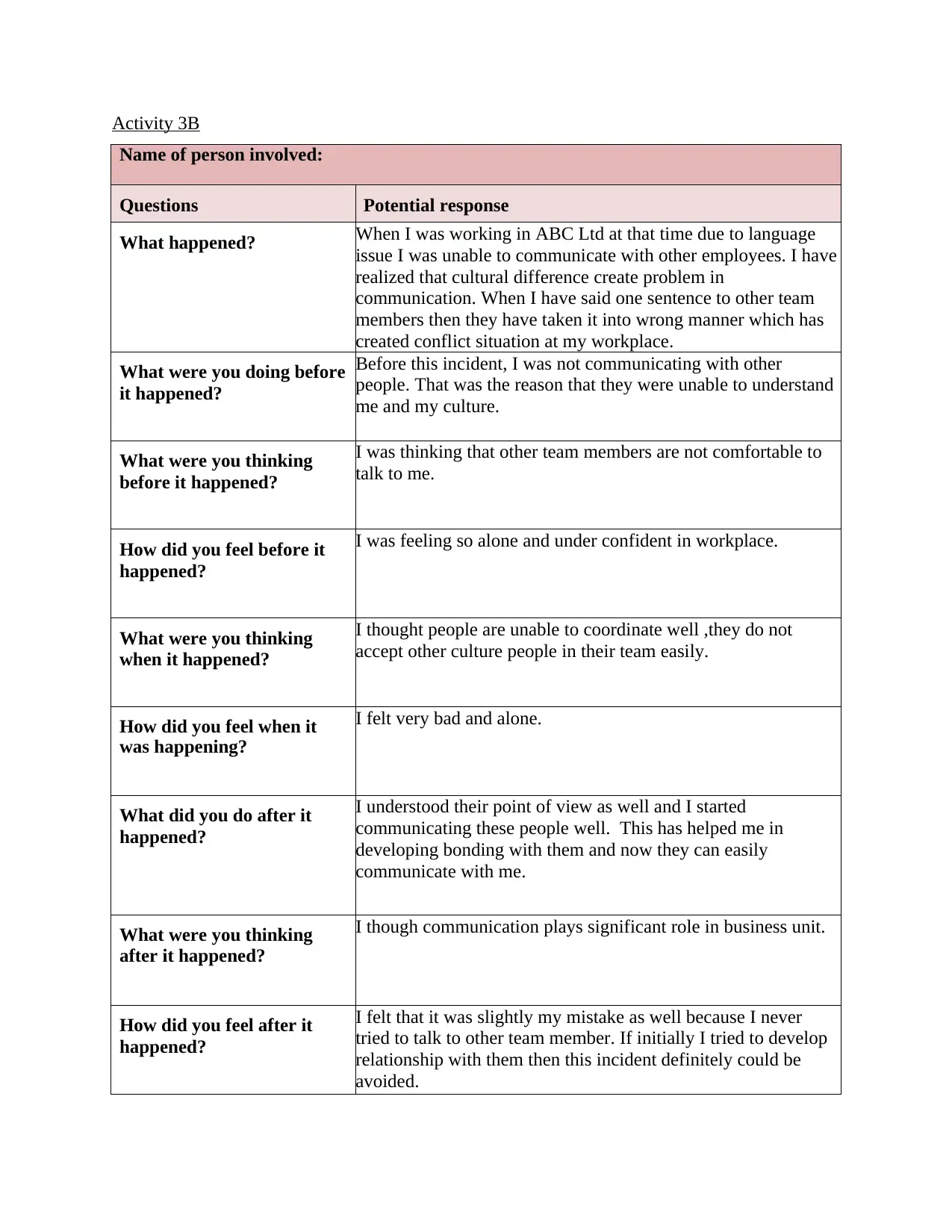
Activity 3B
Name of person involved:
Questions Potential response
What happened? When I was working in ABC Ltd at that time due to language
issue I was unable to communicate with other employees. I have
realized that cultural difference create problem in
communication. When I have said one sentence to other team
members then they have taken it into wrong manner which has
created conflict situation at my workplace.
What were you doing before
it happened?
Before this incident, I was not communicating with other
people. That was the reason that they were unable to understand
me and my culture.
What were you thinking
before it happened?
I was thinking that other team members are not comfortable to
talk to me.
How did you feel before it
happened?
I was feeling so alone and under confident in workplace.
What were you thinking
when it happened?
I thought people are unable to coordinate well ,they do not
accept other culture people in their team easily.
How did you feel when it
was happening?
I felt very bad and alone.
What did you do after it
happened?
I understood their point of view as well and I started
communicating these people well. This has helped me in
developing bonding with them and now they can easily
communicate with me.
What were you thinking
after it happened?
I though communication plays significant role in business unit.
How did you feel after it
happened?
I felt that it was slightly my mistake as well because I never
tried to talk to other team member. If initially I tried to develop
relationship with them then this incident definitely could be
avoided.
Name of person involved:
Questions Potential response
What happened? When I was working in ABC Ltd at that time due to language
issue I was unable to communicate with other employees. I have
realized that cultural difference create problem in
communication. When I have said one sentence to other team
members then they have taken it into wrong manner which has
created conflict situation at my workplace.
What were you doing before
it happened?
Before this incident, I was not communicating with other
people. That was the reason that they were unable to understand
me and my culture.
What were you thinking
before it happened?
I was thinking that other team members are not comfortable to
talk to me.
How did you feel before it
happened?
I was feeling so alone and under confident in workplace.
What were you thinking
when it happened?
I thought people are unable to coordinate well ,they do not
accept other culture people in their team easily.
How did you feel when it
was happening?
I felt very bad and alone.
What did you do after it
happened?
I understood their point of view as well and I started
communicating these people well. This has helped me in
developing bonding with them and now they can easily
communicate with me.
What were you thinking
after it happened?
I though communication plays significant role in business unit.
How did you feel after it
happened?
I felt that it was slightly my mistake as well because I never
tried to talk to other team member. If initially I tried to develop
relationship with them then this incident definitely could be
avoided.
⊘ This is a preview!⊘
Do you want full access?
Subscribe today to unlock all pages.

Trusted by 1+ million students worldwide
1 out of 24
Related Documents
Your All-in-One AI-Powered Toolkit for Academic Success.
+13062052269
info@desklib.com
Available 24*7 on WhatsApp / Email
![[object Object]](/_next/static/media/star-bottom.7253800d.svg)
Unlock your academic potential
Copyright © 2020–2025 A2Z Services. All Rights Reserved. Developed and managed by ZUCOL.



